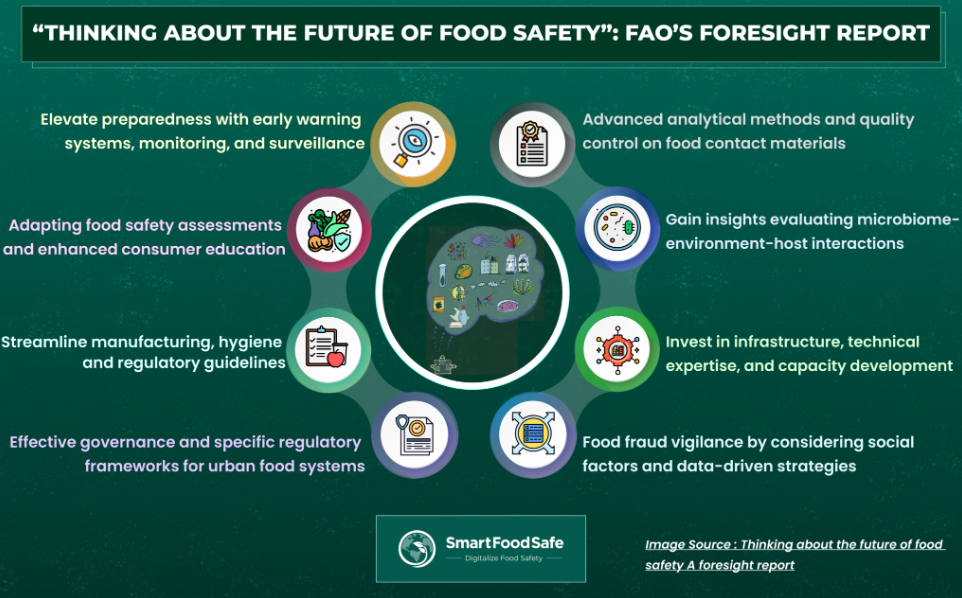
“The future starts today, not tomorrow.” — Pope John Paul II. This is a concept that holds immense power in the realm of the future of food safety, especially with the global population set to reach 9.7 billion by 2050. It brings heightened pressure on ensuring safer, sustainably produced, more affordable, and healthier diets for all, accompanied by the equitable improvement of economic outcomes and livelihoods.
Food safety evidently takes center stage in this system and plays a vital role in preparing to navigate the potential threats, disruptions, and challenges that may arise. The Food and Agriculture Organization of the United Nations released the publication ‘Thinking about the future of food safety: A foresight report’ delving into the FAO food safety foresight program.
Key Takeaways of the FAO Food Safety Foresight Report
To construct agrifood systems that remain robust, sustainable, and equitable in the face of economic, social, and environmental challenges while meeting the needs of the rising world population, tools such as foresight should be undertaken. These would comprise forward-looking approaches required to identify, evaluate, and steer the major global drivers, related patterns, and other problems impacting agrifood systems.
Climate Change & Food Safety Impacts
It is of utmost importance that food supply chains and regulatory bodies elevate their readiness to respond effectively to the climate change influences on food safety. Vital elements for preventing and managing foodborne outbreaks, particularly in climate-sensitive regions, include the establishment of early warning systems and the implementation of monitoring and surveillance techniques. Enhancing preparedness to tackle the influence of climate change on food safety not only supports food security but also contributes to the resilience of agricultural and food systems.
Changing Consumer Preferences & Food Consumption Patterns
In today’s context, changes in consumer behavior are being affected by a wide range of factors, including climate change, an augmented focus on health, especially post-pandemic, the environmental impact of food production, increasing incomes, and various other considerations.
Food safety risk assessments must be adapted to evolving consumer preferences and demands to guarantee consumer protection. Online resources can serve as valuable instruments for engaging and educating consumers about food safety.
New Food Sources & Food Production Systems
The global interest in farming edible insects, seaweed, and jellyfish is growing. As these new food sources are entering new markets, it is paramount to conduct thorough food safety assessments to establish proper hygiene, manufacturing procedures, and regulatory guidelines to ensure safety. Cell-based food production is growing and has begun to be commercialized in some regions, necessitating proper assessment of food safety risks.
Food Safety Considerations for Agriculture Within Urban Spaces
In the context of escalating urbanization and concerns about global food security, urban agriculture is gaining attention. These are agricultural activities carried out within urban areas (intra-urban agriculture), ranging from backyard gardens and community farms to innovative indoor vertical farming methods.
The report highlights essential food safety considerations related to urban agriculture and focuses on the necessity for effective governance and specific regulatory frameworks for urban food systems to ensure food safety.
Exploring Circular Economy Through Plastic Recycling
Unlike a linear approach, the circular economy adopts a systems-based perspective that involves activities and processes aimed at sustainably managing materials within a closed-loop system. It seeks to disconnect plastics from fossil fuel sources, promote sustainable plastic production, repurpose plastic waste, and manage plastic pollution.
Advancements in analytical methods and quality control can help ensure the safety of recycled plastics for their intended use. To boost the safety of food contact materials within the context of a circular economy, collaboration among relevant experts and stakeholders along the supply chain is pivotal.
What are Microbiomes? A Food Safety Perspective
The human gut microbiome is regularly exposed to microorganisms and substances found in the diet. Food additives, residues from veterinary drugs, and environmental contaminants that can alter the gut microbiome and affect the host’s health are now increasingly considered in food safety risk assessments. The all-around understanding of how microbiome-environment-host interactions affect human exposure to different types of biotic or abiotic factors is required, creating a new avenue to grasp health risks and hazards better.
Technological & Scientific Advances
Technological advancements have significantly advanced the capacity to identify contaminants in food, aid in outbreak investigations, enhance predictive analytics for risk identification and improve food supply traceability. This would mean carefully evaluating their benefits and potential threats to food safety.
The rapid advancement of technology often surpasses regulatory development, raising concerns about data governance, privacy, and transparency. To address problems in data governance, transparency, and uneven distribution of cutting-edge technologies, the international community must invest in infrastructure, technical expertise, and capacity development.
Food Fraud
Food fraud is a multifaceted hurdle that often triggers strong consumer reactions and may pose risks to food safety. It is pertinent for food supply chain stakeholders to acknowledge that adverse situations due to food fraud can occur and, hence, must keep their food systems alert and vigilant to combat them. Relying solely on data and data-based techniques may not provide a complete solution to food fraud, and therefore, it is recommended to consider social factors as well. Rather than reacting hastily to every food fraud scandal, it is suggested that we analyze how national and regional approaches can be developed by combining appropriate regulatory strategies.
Smart Food Safe comes forward as a smart investment in technology for safer food through a well-designed suite of digital modules for Food Safety, Quality, Regulatory, and Traceability management with farm-to-fork applications. These tech-enabled solutions contribute to facilitating a better future for food safety by equipping food enterprises to overcome challenges in global food safety drivers and trends, as recognized in FAO’s foresight report.
We enable food industries to exercise end-to-end traceability and optimized control throughout the food supply chain by leveraging capabilities for real-time monitoring of food production, processing, and distribution, ensuring that food safety standards are consistently met at every stage.
_1.png)